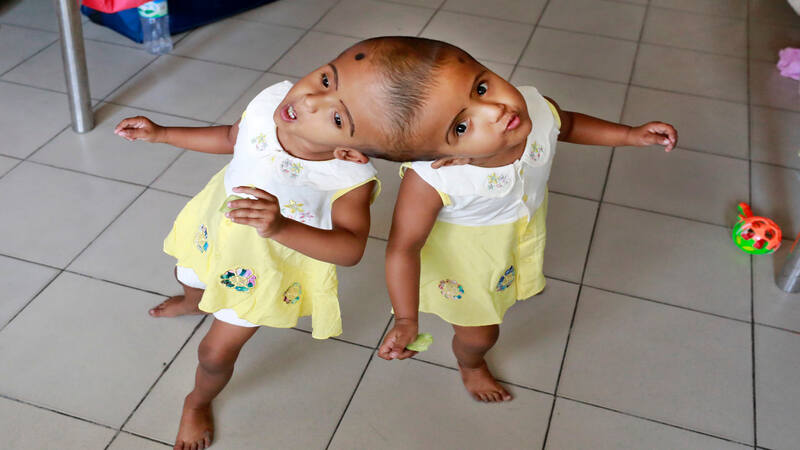
Conjoined twins also known as siamese twins are extremely rare condition. It can occur around 1 in 49,00 to 1,89,000 live births all around the world. A little higher incidence is seen in South West Asia and Africa. It generally happens due to partial splitting of the embryo and it keeps growing and in turn, becomes conjoined twins.
Generally, most of the conjoined twins are stillborn, some would die within 24 hours of the delivery and those who survive can live a long life with a lot of systemic, social, and psychological complications. They can sometimes be the burden of the family.
How Do Conjoined Twins Develop?
Conjoined twins are described as monozygotic identical twins that are partially united and do not separate from one another. This is chiefly due to partial division of the fertilized ovum. Chang and Eng were the first conjoined twins born in Siam (Thailand) hence conjoined twins are also called Siamese twins. The word ‘conjoin’ is derived from the Latin word “conjungere” which means ‘yoke together’ or to join.
Embryologically, conjoined twins develop if an embryo separates partially in two different individuals. The two developing fetuses are formed originally from the same embryo and remain connected physically. The connection is usually at the buttocks, chest or pelvis. Sometimes the Siamese twins share one or more internal organs. Another theory says that two different embryos fuse somehow during initial development and result in conjoined twins.
Classification Of Conjoined Twins
 Depending upon the place where the twins are joined, conjoined twins are classified as under:
Depending upon the place where the twins are joined, conjoined twins are classified as under:
Thoracopagus Conjoined (Joined at the chest)
This is the commonest of all types of conjoined union. The twins are connected at the chest and often share common heart, liver or even upper intestine
Omphalopagus Conjoined (Joined near the bellybutton or umbilicus)
These twins are joined at the umbilicus or the bellybutton. Such twins share liver and few parts of colon and small intestine (ileum
Pygopagus Conjoined (Joined at the base of spine)
Pygopagus twins are joined at lower spine and usually face in opposite direction. Few pygopagus twins have a common gastrointestinal tract, genital and urinary organs
Ischiopagus Conjoined (Joined at the pelvis)
These types of conjoined twins are united at the pelvis. They have a common lower genitourinary tract and liver. They share urinary tract oragns and might have a pair of legs or a fused leg
Craniopagus Conjoined (Joined at the head)
Craniopagus twins are connected at the head and share a part of brain tissue
What Are The Symptoms Of Pregnancy With Conjoined Twins?
Well. speaking about the symptoms there are no specific signs that can help you identify that a pregnant women is carrying Siamese twins. But a few indicators could be as follows:
- The uterus is seen to grow more than the normal pregnancies
- Fatigue, weakness, nausea and vomiting are more pronounced
- Swollen feet are also more prominent in women carrying conjoined pregnancies
Diagnosis Of Conjoined Twins
 The confirm diagnosis of conjoined twins can be made with the aid of ultrasound during the first trimester itself. Ultrasounds and echocardiograms done during the second trimester help in assessing the extent of connection between the conjoined twins and also about the functioning of their internal organs.
The confirm diagnosis of conjoined twins can be made with the aid of ultrasound during the first trimester itself. Ultrasounds and echocardiograms done during the second trimester help in assessing the extent of connection between the conjoined twins and also about the functioning of their internal organs.
Identical twins sharing a common amniotic sac are called monoamniotic twins are usually conjoined twins. According to ultrasonologists false positive tests can be found with ultrasounds done prior to 10 weeks of gestation. MRI or magnetic resonance imaging scan is done to further confirm the presence of conjoined twins. MRI gives you detailed description about the exact place where conjoined twins are connected and the internal organs shared among them.
Risk Factors Of Conjoined Twins
Since the exact cause of conjoined twins is not known, therefore the risk factors are also not very lucid. According to doctors the risk factors are more pronounced in twins developing from two separate eggs. The occurrence is quite rare, and it has been deduced that Latin Americans are more prone to conceiving conjoined twins than American or European couples.
Complications Of Conjoined Twins
The most important complication of conjoint or Siamese twins is stillbirth either inside the mother’s womb or immediately after birth. Normal vaginal delivery should not be attempted in conjoint twin pregnancy, C-section is strongly recommended. Many a times, conjoined twins are still born or die. A skilled team of doctors and surgical staff generally handles the cases of conjoined twins. Well-equipped C-section or surgical delivery can be planned for cases which are likely to survive before the due date. Sometimes if one of the twins’ dies, emergency separation should be done to save the life of the other twin.
Only about half of the conjoined twins born survive long enough to get the separation surgery done.
Factors Influencing The Decision Of Surgery
Once the diagnosis is made regarding the conjoined twins, close monitoring is needed to know as much as plausible about the fetuses’ anatomy, prognosis after birth, and functional capabilities. This monitoring of pregnancy will enable your doctor to plan the treatment schedule for the twins. A planned C-section is well planned 2 to 4 weeks before the due date. It is only after the birth the doctors will be able to say whether a separation surgery can be done or not. Here are some important points that will help the doctors determine the same:
- Whether the twins share their vital organs?
- Whether the twins are healthy and can undergo surgery?
- The doctors will figure out the odds concerned with successful separation
- What reconstructive surgeries could be needed after the separation operation
- What could be the probable issues the twins have to face if they are left as conjoined?
If somehow the separation surgery is not advised by your doctor or you feel that it should not be done, do not attempt it. Comfort care for example fluids, adequate nutrition, pain relief, and human touch is required to allay the condition. Spend time with your tiny babies and learn to accept them as they are. You can take the help of a counselor and talk to your spouse regarding the same.
Coping and Support – Loss And Other Life-threatening Conditions
Once the pregnancy confirms that you are carrying conjoined twins, it is very likely that you will go through many emotions regarding the future of your unborn babies. Not only is this difficult because two babies are involved, but also because their survival is a question mark. Many parents worry about the obstacles their babies will face. Difficult decisions on the part of parents are called for. Due to the rarity of the occurrence of conjoined twins, you may not find many parents who have sailed in the same boat, yet you could find some support groups consisting of parents who have either lost their babies are the babies have some life threatening conditions. Getting in touch with these organizations may help you cope with your situation, as well you may find people who can support you in difficult times.
Being discussed in detail about conjoined twins in this article we all can see that the quality of life of both parents and the twins is not very good. If it is diagnosed early in the pregnancy then a decision of abortion will be a humane decision for the babies. If twins are born and they survive the proper treatment under trained health care professionals is needed. During pregnancy also proper checkup with all targeted ultrasounds to be done to avoid conjoined twins.
FAQ’s
1. What Causes A Conjoined Twin?
Conjoined twins are rare phenomenon. It happens during the splitting of the embryo, when the embryo is splitting to become two the processes stops before a complete split can happen. This gives rise to conjoined twins.
2. Do Any Conjoined Twins Have Kids?
It is uncommon and unheard of that a conjoined twins are having their offsprings. If they are separated they might have offsprings.
3. How Long Can Conjoined Twins Live?
Around 50% of conjoined twins die within 24 hours of delivery. If survive they can live longer life which can be equal to normal human beings.
4. What Happens If One Of The Conjoined Twins Dies?
If the conjoined twins are not separated then if one dies the toxins from the dead twin can travel to the live twins and eventually after some time they can all pass away.
